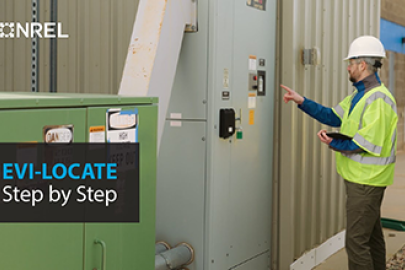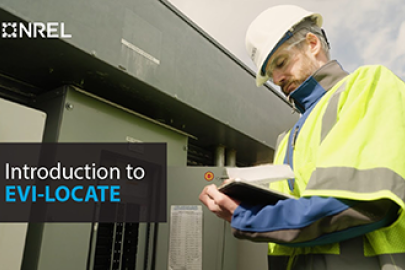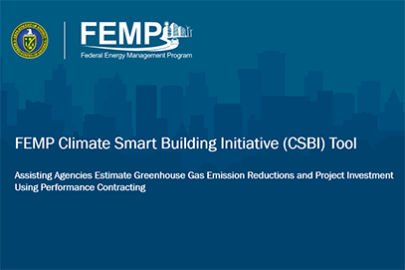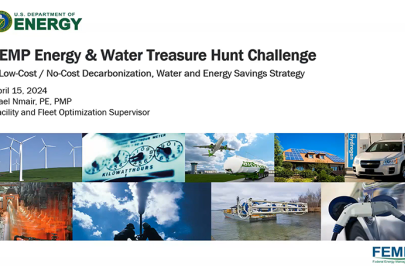This video provides an overview of the Smart Labs process – a set of replicable and scalable procedures to improve the performance of laboratories both in terms of safety and efficiency.
Federal Energy Management Program
August 4, 2020The Federal Energy Management Program's (FEMP) Smart Labs initiative enables safe and efficient world class science to occur in laboratories through high-performance methods. A Smart Labs program employs a combination of physical, administrative, and management techniques to assess, optimize, and manage high performance laboratories.
This video provides an overview of the Smart Labs process. It provides executive and key stakeholders with a clear understanding of the goals, objectives, and benefits of a Smart Labs program.
[Music plays; the Smart Labs logo appears followed by the text: "The path to greater success." Followed by, "Why Smart Labs?"]
Narrator: Smart Labs offers a proven process and a set of procedures that improves the performance of your lab. It ensures that the right airflow is in the right place at the right time.
It's replicable and scalable, delivering predictable results and a demonstrable return on investment. The result is improved safety, reduced waste, and better outcomes. And that can make your organization more effective and better able to attract and retain world-class talent and it all begins with airflow and ventilation.
In this series of videos, we'll hear from industry experts with firsthand experience in solving complex airflow problems. We'll talk about how to plan, assess, optimize, and manage your Smart Lab.
This video is an overview primarily for executive and key stakeholders. It provides a clear understanding of the goals, objectives, and benefits of the Smart Labs process.
We'll also talk about the very real risks or your team and your organization if you aren't using Smart Lab processes and procedures.
[Text on the screen reads: "The importance of labs and critical workspaces."]
Narrator: Let's start at the beginning. Why are labs and critical workspaces so important?
Many of mankind's greatest achievements happened in a lab. From the discovery of penicillin to the development of advanced medical treatments and pharmaceuticals to decoding DNA, the creation of advanced materials, the invention of the transistor, safety glass, and even Super Glue...these discoveries and countless more all happened in a lab.
Thousands of organizations around the globe rely on lab-based research and development. Thousands more have critical workspaces or areas where the environmental conditions must be controlled within tight tolerances.
But how is a lab different from other facilities, and what makes a lab a good lab?
[Tom Smith, President of 3Flow, appears and is introduced on screen.]
Tom Smith: Well, laboratories require controlled environments, sometimes for the purpose of protecting people from exposure to airborne hazards, sometimes from physical hazards, other times for temperature control, and to control the environmental conditions within a space.
And so, they're really more of a tool to help the researcher be successful, whereas an office space or something like that doesn't have the same requirements for ventilation and control of the conditions.
A good lab is one that meets the needs of the occupants and helps them be more successful in their science and provides a safe and comfortable environment for them to work.
Narrator: But meeting the needs of the occupants isn't as simple as it sounds. There is a very real risk that the safety of your team and the validity of your research is in jeopardy, right now.
Tom Smith: So, it's estimated that there is somewhere between 800,000 and 1.4 million fume hoods in the United States.
We've tested about 40,000 installations. We've done hundreds of laboratories. And so, we have a very, very large database of information to draw from, and unfortunately, we see problems in the majority of these spaces.
Fifteen to 30% of fume hoods that we've tested don't function properly and are probably people are probably being overexposed to the hazards that are meant to be protected. One, about 1 out of every 3 ventilation systems has significant operational problems that may impact the air quality within the building, causing people to maybe suffer adverse health effects.
Some of those are acute, where they may be feeling those effects very short term, and some of them may be longer-term where you may not have the, what they call a latent effect—it may not occur for 5, 10, 15 years down the road.
So, it's hard to associate those with the exposure that may have occurred.
[Brad C. Cochran, Principal, CPP, appears and is introduced on the screen.]
Brad Cochran: One of the, kinda the highlights that I use is, if you walk into a hospital and you go into the lobby and it smells like disinfectant and so you think it's nice and clean?
Chances are, that disinfectant is coming from the operating room and that exhaust is being re-entrained back into the lobby. So, in fact, even though it smells clean, it's anything but clean. You know, you have whatever else is in that operating room is in the lobby associated with it.
Tom Smith: There are circumstances where, if you looked at the critical environments, it can impact the quality of the data. So, if you had a medical testing laboratory where the systems weren't operating effectively, it may impact the quality of the results and the decisions made based on those results and then operations and surgeries may have been conducted either needlessly or improperly because of the data.
[Brent Nelson, Manager of Engineering and Informatics at the National Renewable Energy Laboratory (NREL) appears and is introduced on screen.]
Brent Nelson: If you have dirty air and you have particulates in your experiment, if you have the wrong humidity, if you have the wrong temperatures, if you have wildly fluctuating parameters and your experiments are sensitive to the environmental parameters that the ventilation provides, then that will adversely affect your results. So, it's critical in some cases...it's very critical that you have the right ventilation for the right research.
Brad Cochran: Now, the other side of it is, is that we find that there's an awful lot of energy wasted in those systems, that we're designing them using rules of thumb that are meant for worst-case emissions scenarios, worst case wind conditions, and so, these systems end up running 24/7...under conditions that they really don't need to, and so, there's a big opportunity or energy savings associated with that.
[Otto Van Geet, Principal Engineer at NREL, appears and is introduced on screen.]
Otto Van Geet: The benefits of a Smart Lab program is that you first can do world-class research...that is why we built the lab...make sure you're doing that world-class research in a safe way, and then third, make sure that you're minimizing your resources, primarily energy in this case, but also water and materials to meet that research need. And then use that saved money to do more research.
Tom Smith: The value of people working in a space can be underestimated. I mean, the human life is so important and we have an obligation, when people are working with hazards, to understand the hazards and protect them. So, ventilation is a very, very important aspect of that safety measure.
[James Palesch, Lab Supervisor at NREL, appears and is introduced on screen.]
James Palesch: Yeah, I would feel unsafe if the HVAC was not functioning. You come to rely on it a lot more...I mean, it's one of those things that you don't think a whole lot about it, but when I ponder the fact, if the HVAC went out, how would I feel? Would I really wanna be in this environment? No, I wouldn't.
[Jason Zack, Research Technician at NREL, appears and is introduced on screen.]
Jason Zack: Having a lab space that's in good condition and has good working equipment and safety equipment and ventilation is huge for me. Years back, I think when I started here at NREL, I once heard an EH&S gentleman say, you know, everybody has the right to go home the way they came in...And that's true...I want to go home the same way I came in.
Narrator: Safety is clearly the number one priority in any critical workspace or lab, and ventilation is the first line of defense. The ventilation also ensures environmental consistency and the quality and reproducibility of your experimental results.
And yet, 1 in 3 ventilation systems has significant operational problems that could threaten the safety of your employees, and as many as 7 out of 10 systems are operating poorly enough that the reproducibility and validity of your lab results could be in question.
Airflow systems can lose up to 50 percent of their airflow controllability within 5 years. This is compounded by the fact that building maintenance systems do not take a facility-wide approach to airflow and ventilation, and that presents all kinds of risks for your organization.
Tom Smith: So, organizations that rely on research and development for developing new technologies or new products...if they do not implement programs like this, they're at risk of potentially jeopardizing their main mission. That's one risk.
Secondly, they risk their most valued assets, which are their people, from a safety standpoint, and if people get exposed, then there's potential risk and liability, and then there's excess waste associated with the operation of the systems.
[Text appears on screen: "The Role of the Executive Champion."]
Tom Smith: A senior executive needs to drive the success of the organization, and the laboratories and the research that's conducted there and is oftentimes the fundamental driver of the success of that organization.
Sometimes, it's basic research, and sometimes, it's scale-up and it's products that are coming to market.
If the labs are not operating effectively, then that compromises the ability of the researchers to meet their mission.
And so, it could jeopardize the competitiveness of the organization and their ability to meet the stakeholders' concerns and meet their obligations as an executive leader.
Narrator: As an executive champion, you know that better science is better for your organization. Safety is always a primary concern, and reducing waste can only improve your organization's bottom line.
By implementing Smart Labs, your organization can reduce risk, potential liability, and operating costs...all while doing better work.
Tom Smith: So, the executives that understand the value of Smart Labs realize that they can better meet their own mission by enabling the operation of the facilities to function properly, they can reduce cost, and they can be a leader.
They don't have to know all of the details...they have really qualified staff. They just need to coordinate that staff, give them a coordinated, comprehensive mission, and then allow them to do their job, and then provide the resources to do so.
Narrator: An executive champion is also far better positioned to see the long-term vision for the organization, to drive stakeholder alignment, and to ensure accountability and the measurement of results.
[Text appears on screen: "The Path to Greater Success."]
Tom Smith: I was at a Green Labs conference at Harvard and I was talking to a professor there, and he stated that good science can happen in a bad building, but a bad building can affect good science.
Narrator: How can you improve safety, reduce risk, and improve both your top and bottom line? The answer is Smart Labs.
For more information, please visit our website at smartlabs.i2sl.org.










